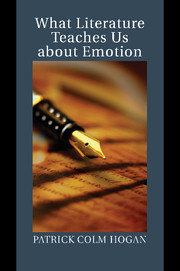Book contents
- Frontmatter
- Contents
- List of Figures
- Acknowledgments
- Introduction: Studying Literature Studying Emotion
- 1 Fictions and Feelings
- 2 What Emotions Are
- 3 Romantic Love
- 4 Grief
- 5 Mirth
- 6 Guilt, Shame, Jealousy
- 7 From Attachment to Ethical Feeling
- 8 Compassion and Pity
- Afterword: Studying Literature Shaping Emotion
- Works Cited
- Index
- Title in the series
Afterword: Studying Literature Shaping Emotion
Madame Bovary and the Sublime
Published online by Cambridge University Press: 03 May 2011
- Frontmatter
- Contents
- List of Figures
- Acknowledgments
- Introduction: Studying Literature Studying Emotion
- 1 Fictions and Feelings
- 2 What Emotions Are
- 3 Romantic Love
- 4 Grief
- 5 Mirth
- 6 Guilt, Shame, Jealousy
- 7 From Attachment to Ethical Feeling
- 8 Compassion and Pity
- Afterword: Studying Literature Shaping Emotion
- Works Cited
- Index
- Title in the series
Summary
In the preceding chapters, we stressed the ways literature depicts “real life” emotions and fosters empathic versions of those emotions in readers. But stories not only elicit short-term emotion events in readers; they affect our long-term emotional responsiveness – a point depicted by authors themselves since at least Don Quixote. Indeed, there would hardly be any point in treating moral or political issues in literature if the emotional effects of a work lasted merely a few minutes beyond the reading itself.
Literature can have moral consequences only insofar as it alters what we feel about situations and people, what we are motivated to do in our personal and social lives. As the example of Don Quixote suggests, this may occur through our precise imagination of goals, our construal of conditions in which we find ourselves, or other aspects of elaborative processing. Guided by stories, such processing may, in our imagination, transform windmills into threatening adversaries – or, what is more likely, an innocuous dark-skinned fellow passenger on a plane into a sinister terrorist.
Literary works also create emotional memories that may inflect our responses to the world long after reading. For example, consider Kamala Markandaya's treatment of rural poverty and hunger in Nectar in a Sieve. Many readers (including myself) are deeply moved by the events of this novel. This experience forms emotional memories that should have consequences when those readers hear reports of hunger or witness rural poverty.
- Type
- Chapter
- Information
- What Literature Teaches Us about Emotion , pp. 287 - 304Publisher: Cambridge University PressPrint publication year: 2011



